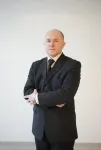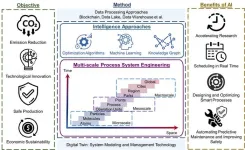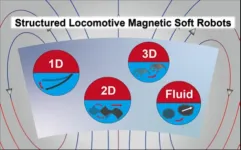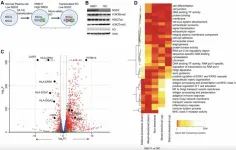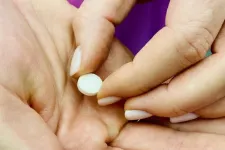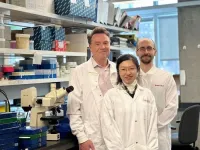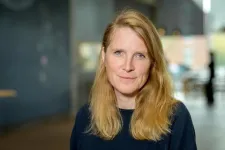(Press-News.org) When spring arrives and the heating season comes to an end, keeping warm becomes less of an issue. However, scientists remind us that it is not just a seasonal necessity – heat is also a valuable energy resource that can be stored and used when needed most. Researchers at Kaunas University of Technology (KTU) have discovered an innovative solution beneath our feet: using soil as an efficient thermal energy storage system.
KTU professor Dr Tadas Ždankus and his team have been investigating how the ground can serve not only for construction purposes but also as a medium for heat storage. At the core of their research is a ground-based heat accumulator that would store excess energy underground and make it available when demand peaks. “Our goal was to convert heat, which would normally dissipate into the ground as waste, into a useful energy source,” explains Dr Ždankus.
Underground heat storage potential
At the beginning of their research, Prof. Ždankus and the team explored how wind energy could be used to produce heat instead of electricity. Instead of a conventional generator, they employed a hydraulic system. The researchers found that so-called hydraulic losses, typically seen as inefficiencies, were actually generating usable heat. “The hydraulic losses we were trying so hard to eliminate turned out to be nothing less than heat generation,” says a KTU professor.
However, a portion of this heat was lost before reaching the buildings it was meant to warm during colder seasons. “The question became how to not only reduce heat loss to the ground but also store and retain it for future use,” adds Ždankus.
To test this idea, the researchers conducted experiments using an artificial heat source placed in surface soil layers. They measured how heat spreads, how fast it moves, and how long it persists in the ground. In one test, the soil was heated to the point where moisture began to evaporate – triggering a phase change, in which liquid water becomes vapor.
“Phase change can be an efficient way to store heat. The significantly higher amount of energy can be charged into the soil,” explains a KTU professor.
As vapour travels through the ground, it distributes heat over a wider area. “We noticed a sharp temperature rise wherever the vapour flow reached. This means the energy is moving and can be controlled,” says Prof. Ždankus.
Such a system could help balance district heating networks or alleviate stress during power grid overloads. “It’s also possible to install thermal accumulators for individual use – beneath residential buildings, streets, or parking lots,” he adds.
This research demonstrates that underground heat storage can be far more efficient than previously believed. In addition, similar principles could apply to cooling. “Underground cold or coolness storage is also possible,” notes a KTU expert.
Turning ground into an energy cell
Once the feasibility of underground heat storage was confirmed, researchers began exploring its practical applications. They wanted to see if the soil beneath buildings could passively store heat, making use of the natural downward flow of heat from buildings into the ground. “We started in the laboratory. A prototype ground energy cell was developed alongside a testing setup to study how heat spreads through the soil. Temperatures were measured at various depths, including at the surface and in the air,” explains Dr Ždankus.
The team examined how long the soil retained heat and how quickly it returned to its original temperature. These findings helped assess the long-term reliability of such a storage method.
KTU master’s students were also involved in the project. Measurements and calculations spanned an entire year, which enabled the team to monitor seasonal effects and compare results with existing climatological data. “The year-long measurements revealed natural seasonal patterns in soil temperature and allowed us to identify several trends,” the professor shares.
Additional numerical simulations were performed to evaluate potential heat losses and the effectiveness of heat storage under buildings. “We found that even the passive use of an isolated soil volume beneath a building can reduce heat loss and increase its energy efficiency. Less heat loss means less energy needed for heating, which in turn leads to energy savings. If that heat comes from burning fossil fuels or biomass, our solution also lowers carbon dioxide emissions,” notes Ždankus.
To make these ground-based storage systems viable for widespread use, researchers are now developing scaled-down prototypes and refining heat distribution control methods. According to the scientist of the KTU’s Faculty of Civil Engineering and Architecture, the project is evolving through collaboration with experts in various fields – from geotechnical engineers to energy system specialists.
“Our immediate goal is to integrate existing solutions, such as boreholes, piles, and other underground heat exchange technologies into a system that can benefit both industry and residential sectors,” he concludes.
The article “Research on Increasing the Building's Energy Efficiency by Using the Ground Beneath It for Thermo-Accumulation” is available here.
END
KTU researchers explore using soil for heat storage
Researchers at Kaunas University of Technology (KTU) have discovered an innovative solution beneath our feet: using soil as an efficient thermal energy storage system.
2025-04-02
ELSE PRESS RELEASES FROM THIS DATE:
Sociology leaders rally in support of academia, urge protection of free inquiry and research
2025-04-02
The American Sociological Association has led a coalition of leading sociological organizations to issue an open letter defending the vital role of sociology in universities and society while condemning recent federal actions that threaten academic inquiry and free speech. Signed by the presidents of ten major sociological associations, the letter calls on university leaders, policymakers, and the public to resist efforts that undermine the discipline and stifle research that benefits society.
The signatories express their growing concerns over abruptly canceled federal contracts, looming job losses for sociologists ...
Exploring AI’s role in decarbonizing the chemical industry: A multi-scale perspective
2025-04-02
As the chemical industry seeks sustainable transformation, decarbonization requires intelligent solutions across multiple scales to enhance efficiency and reduce emissions. A research team led by Professor Xiaonan Wang at Tsinghua University has systematically reviewed AI-driven multi-scale smart systems for decarbonizing this energy-intensive sector. Published in Technology Review for Carbon Neutrality, the study explores innovations from materials discovery to industrial park optimization, highlighting ...
A review on structured magnetic soft robots: Locomotion innovation driven by structural engineering
2025-04-02
Recently, Dr. Renheng Bo, Research Associate Professor at the State Key Laboratory of Flexible Electronics Technology, Tsinghua University, and his colleagues published a new review article entitled "Structured Locomotive Magnetic Soft Robots" in Flextech. This article focuses on the relationship between structural configurations and locomotion modes of magnetic soft robots, which systematically summarizes the material compositions, fabrication methods, locomotion mechanisms, and applications of existing magnetic soft robots. Furthermore, it emphasizes current challenges and future research directions in the field of structured ...
NCCN 2025 Annual Conference illustrates the critical impact of cancer research on improving lives
2025-04-02
ORLANDO, FL [April 2, 2025] — The National Comprehensive Cancer Network® (NCCN®)—an alliance of leading cancer centers—celebrated 30 years of helping people with cancer to live better lives during the NCCN 2025 Annual Conference, March 28-30 in Orlando, Florida. The yearly event brings together leading minds and subject matter experts in front of a multidisciplinary audience to share the latest recommendations for cancer treatment and prevention.
“We are proud to honor our founders’ vision of sharing evidence-based, expert consensus-driven recommendations through clinical practice guidelines to improve ...
NSD2 gene drives cancer cell identity in multiple myeloma
2025-04-02
“Our findings suggest a role for NSD2 in maintaining MM cell identity, with potential implications for future therapeutic strategies based on targeting of NSD2.”
BUFFALO, NY – April 2, 2025 – A new research paper was published in Oncotarget, Volume 16, on March 21, 2025, titled “NSD2-epigenomic reprogramming and maintenance of plasma cell phenotype in t(4;14) myeloma.”
Researchers Andrea Gunnell, Scott T. Kimber, Richard Houlston, and Martin Kaiser from The Institute of Cancer Research, London, studied how a gene called ...
From octopus intelligence to smart artificial blood vessels: 2025 Schmidt Science Fellows to break new ground with interdisciplinary research
2025-04-02
NEW YORK—Thirty-two early career researchers, tackling issues from improving food security to developing better medical implants, were awarded up to two years of grant funding to pursue innovative interdisciplinary science, Schmidt Science Fellows announced today.
Now in its eighth year, the fellowship, a program of Schmidt Sciences, provides financial support for a postdoctoral placement of one to two years at a world-class research institution. The funding equips scientists to apply their knowledge to a new field of study with the goal ...
Experts challenge aspirin guidelines based on their undue reliance on a flawed trial
2025-04-02
Recent guidelines have restricted aspirin use in the primary prevention of cardiovascular disease. The American Heart Association (AHA)/American College of Cardiology (ACC) guidelines restricted aspirin to patients under 70, and more recently, the United States Preventive Services Task Force restricted aspirin use to patients under 60. However, heart attack and stroke risks both rise with age, leaving health care providers unsure about when to stop prescribing aspirin, whether it should be used for primary prevention, and which patients would benefit most.
Researchers from Florida Atlantic University’s ...
McGill discovery sheds new light on autism, intellectual disabilities
2025-04-02
A new study by McGill University researchers yields insights into how the disruption of calcium transport in the brain is linked to autism and intellectual disability. The findings, published in the journal Nature, not only upend a long-held belief among neuroscientists, but could pave the way for treatments.
The researchers discovered that tiny protein structures on brain cells, known as AMPA receptors, can transport calcium. While previous research had suggested that disruptions in calcium ...
Cellular changes occur even below the hexavalent chromium limit
2025-04-02
In Sweden, around 18,000 workers are exposed to hexavalent chromium in their workplace. Hexavalent chromium is a powerful carcinogen that is released, for example, during welding of stainless steel or the manufacture of paints and rustproofing.
Thirty years ago, the limit for hexavalent chromium in Sweden was set at 5 micrograms per cubic metre of air. It is a technically calculated value that was determined based on what industry was considered to be able to handle at the time, rather than medical studies examining the level at which people start developing ...
Study suggests a new way to curb social media’s body image toll
2025-04-02
PULLMAN, Wash. — Reflecting on how fitness posts on social media make them feel may help young women reduce the harmful tendency to compare themselves to idealized influencers and content online.
That’s according to a new study published in Health Communication that explores the impact of “fitspiration”—fitness-themed inspirational content—on young women’s body image, and whether short, daily reflections could lead to meaningful changes in their emotions and self-perception.
Led by Jessica Willoughby, associate professor of communication at Washington State University, the research found that sending young women twice-daily ...
LAST 30 PRESS RELEASES:
Scalable and healable gradient textiles for multi‑scenario radiative cooling via bicomponent blow spinning
Research shows informed traders never let a good climate crisis go to waste
Intelligent XGBoost framework enhances asphalt pavement skid resistance assessment
Dual-function biomaterials for postoperative osteosarcoma: Tumor suppression and bone regeneration
New framework reveals where transport emissions concentrate in Singapore
NTP-enhanced lattice oxygen activation in Ce-Co catalysts for low-temperature soot combustion
Synergistic interface engineering in Cu-Zn-Ce catalysts for efficient CO2 hydrogenation to methanol
COVID-19 leaves a lasting mark on the human brain
Scientists use ultrasound to soften and treat cancer tumors without damaging healthy tissue
Community swimming program for Black youth boosts skills, sense of belonging, study finds
Specific depressive symptoms in midlife linked to increased dementia risk
An ‘illuminating’ design sheds light on cholesterol
Who is more likely to get long COVID?
Study showcases resilience and rapid growth of “living rocks”
Naval Research Lab diver earns Office of Naval Research 2025 Sailor of the Year
New Mayo-led study establishes practical definition for rapidly progressive dementia
Fossil fuel industry’s “climate false solutions” reinforce its power and aggravate environmental injustice
Researchers reveal bias in a widely used measure of algorithm performance
Alcohol causes cancer. A study from IOCB Prague confirms damage to DNA and shows how cells defend against it
Hidden viruses in wastewater treatment may shape public health risks, study finds
Unlock the power of nature: how biomass can transform climate mitigation
Biochar reshapes hidden soil microbes that capture carbon dioxide in farmland
Reducing saturated fat intake shows mortality benefit, but only in high-risk individuals
Manta rays create mobile ecosystems, study finds
Study: Mixed results in using lipoic acid to treat progressive multiple sclerosis
Norbert Holtkamp appointed director of Fermi National Accelerator Laboratory
New agentic AI platform accelerates advanced optics design
Biologists discover neurons use physical signals — not electricity — to stabilize communication
Researchers discover that a hormone can access the brain by hitchhiking
University of Oklahoma researcher awarded funding to pursue AI-powered material design
[Press-News.org] KTU researchers explore using soil for heat storageResearchers at Kaunas University of Technology (KTU) have discovered an innovative solution beneath our feet: using soil as an efficient thermal energy storage system.
